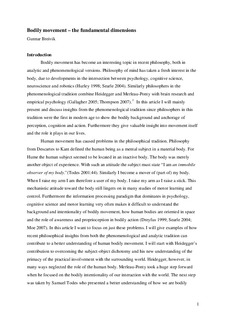| dc.contributor.author | Breivik, Gunnar | |
| dc.date.accessioned | 2009-02-16T11:39:16Z | |
| dc.date.issued | 2008-12 | |
| dc.identifier | Seksjon for kultur og samfunn / Department of Cultural and Social Studies | |
| dc.identifier.citation | Sport, Ethics and Philosophy. 2008, 2(3), 337-352 | en |
| dc.identifier.issn | 1751-133X | |
| dc.identifier.uri | http://hdl.handle.net/11250/170399 | |
| dc.description | I Brage finner du siste tekst-versjon av artikkelen, og den kan inneholde ubetydelige forskjeller fra forlagets pdf-versjon. Forlagets pdf-versjon finner du på www.informaworld.com: http://dx.doi.org/10.1080/17511320802475754 / This is an electronic version of an article published in Sport, Ethics and Philosophy. In Brage you'll find the final text version of the article, and it may contain insignificant differences from the journal's pdf version. The original publication is available at www.informaworld.com: http://dx.doi.org/10.1080/17511320802475754 | en |
| dc.description.abstract | Bodily movement has become an interesting topic in recent philosophy, both in analytic and phenomenological versions. Philosophy from Descartes to Kant defined the human being as a mental subject in a material body. This mechanistic attitude toward the body still lingers on in many studies of motor learning and control. The article shows how alternative philosophical views can give a better understanding of bodily movement. The article starts with Heidegger's contribution to overcoming the subject-object dichotomy and his new understanding of the primacy of the practical involvement with the surrounding world. Heidegger, however, in many ways neglected the role of the human body. Merleau-Ponty took a huge step forward when he focused on the bodily intentionality of our interaction with the world. The next step was taken by Samuel Todes who presented a better understanding of how we are bodily oriented in space. After having seen how the body is oriented outward towards the environment it is proper that the final part of this article goes inward toward the role of bodily awareness and the role of proprioception in human movement. The goal of the presentation is to contribute to a better understanding of what goes on in sport. The article therefore uses examples from sport, especially football, to show the relevance of the new insights for sport studies. | en |
| dc.format.extent | 80925 bytes | |
| dc.format.mimetype | application/pdf | |
| dc.language.iso | eng | en |
| dc.publisher | Routledge | en |
| dc.subject | ethics philosophy | en |
| dc.subject | sport studies | en |
| dc.title | Bodily movement : the fundamental dimensions | en |
| dc.type | Peer reviewed | en |
| dc.type | Journal article | en |
| dc.subject.nsi | VDP::Humanities: 000::Philosophical disciplines: 160 | |
| dc.subject.nsi | VDP::Humanities: 000::Social science in sports: 330 | |
| dc.source.pagenumber | 337-352 | en |
| dc.source.volume | 2 | en |
| dc.source.journal | Sport, Ethics and Philosophy | en |
| dc.source.issue | 3 | en |
